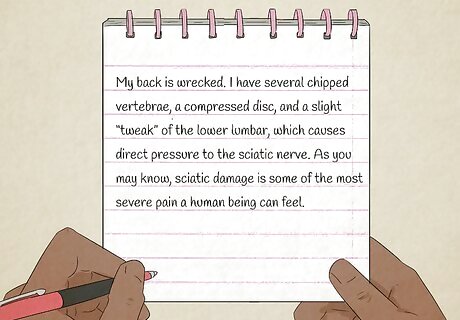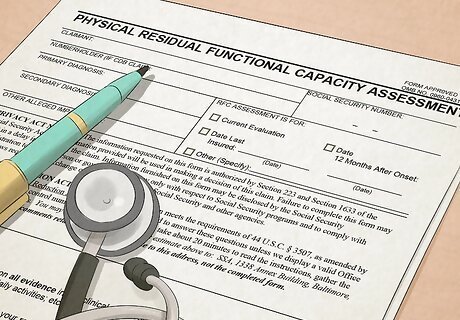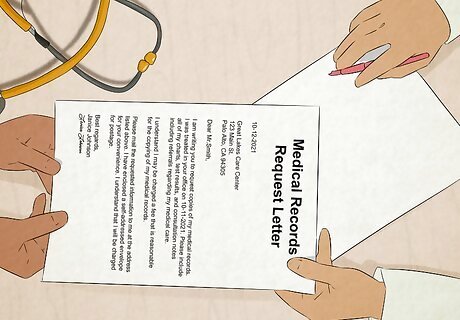
views
- Choose the doctor you have the best relationship with or see the most often to be your preferred advocate. Then, make an appointment with them to discuss your disability.
- Bring the proper forms to your appointment, like the residual functional capacity (RFC) form, if you’re filing for disability benefits with Social Security.
- At the appointment, explain why you want to go on disability and be as detailed as possible. Answer your doctor’s follow-up questions honestly, and wait for their decision.
Medical Appointment Prep

Start the process before you submit a disability claim. The most common reason that claims are denied is because there is not enough proof of a disability. Wait until you have spoken to your doctor to submit your claim. This will ensure that the doctor is willing and able to provide support. If you have applied for Social Security benefits and were denied, you can appeal. In this case, you will have to go before a judge. Get the doctor’s letter of support before you go to the judge or you may lose the appeal.

Choose the right doctor as your preferred advocate. If you have multiple doctors, the doctor that sees you most frequently is often the best person to ask. They will know the most about you and your condition. If you only have one doctor or if your condition is not currently being treated, your primary care physician will be your best bet. You must have an M.D., D.O., or Ph.D. fill out the form or letter for you. You cannot ask a nurse or physician’s assistant. If you have a mental condition, such as anxiety or depression, you should go to your psychiatrist if you have one. The best doctor to ask is one with whom you have a long relationship. If you ask a new doctor, they may not know enough about you or your condition to write an accurate letter.

Write down as much detail about your condition as possible. Use specific examples from your life to show the daily impact of your disability. You can give this written statement to your doctor. In general, your doctor will need to know: When the condition started. For example, write down when you first experienced symptoms or identify how many years you have struggled with it. How the condition affects your life. For example, if you have severe depression, you may not leave your house for long periods of time. How the condition impacts your ability to work. For example, if you have a back injury, you may no longer be able to work your job in a warehouse. How the condition affects your ability to stand, sit, walk, or remember. For example, if you have arthritis, you may not be able to bend or stoop.

State that you want to discuss disability when you make the appointment. The discussion will go more smoothly if the doctor is expecting it. Informing your doctor ahead of time will help them prepare for the discussion by studying your medical records. When you call, you can say, “I am filing for disability benefits, and I would like to talk to Dr. Stevens about supporting my application.” Don’t try to squeeze the discussion in during a medical visit. Your doctor may not have time to both treat your condition and talk about your disability claims. While some doctors may offer walk-ins, it is best to make an appointment for this type of visit. This will ensure that the doctor has enough time to fully talk about the issue with you.
Requesting Medical Support

Bring the proper forms with you. In some cases, the doctor may be asked to write a letter that answers certain questions about your disability. In other cases, the doctor might have to fill out a form. In both situations, you should bring the document with the questions or requirements when you go to the appointment. If you are filing for disability benefits with the Social Security Administration (SSA), bring a residual functional capacity (RFC) form. There are separate forms for physical and mental conditions. You can find these online or at a Social Security Center. If you are filing for disability benefits from a state, contact either your state’s Department of Health or Department of Labor for more information. If you are asking for disability for extra assistance or an excused leave in school or university, ask the administration for the proper forms. If you need the disability forms for work, human resources (HR) should be able to help you. If you work for a small business, ask your boss.

Explain why you want to go on disability. State how your condition prevents you from working and how your disability claim could help. Use specific examples from your life to help illustrate the struggles. Describe in detail how the condition affects your life. You might say, "Because of my medications, I can no longer drive. Unless I can get a ride, I am stuck in my house." Emphasize how this claim could help you recover. You might say, “I think I need some time to focus on my recovery so that I can eventually become healthy.” If you are filing for benefits, explain how they will help you pay for treatment. You might say, “It’s very hard for me to afford my treatments right now. If I could get benefits, I would be able to get the care that I need.”

Answer your doctor’s questions honestly. In some cases, differences between what your doctor says and what your medical records state can cause you to lose your disability claim. If your doctor asks you questions about your condition, it is in your best interest to be as honest as possible. For example, if your doctor asks how long your condition has lasted, don’t add months or years to make it sound more severe. Instead, give them an honest answer. If you can’t remember, tell them. They can consult your records.

Handle rejection gracefully. Some doctors may be reluctant to offer assistance when filing for disability. If your doctor disagrees, you can try to calmly explain your position again. Try to avoid crying, shouting, or fighting with your doctor. Thank the doctor for their time if they refuse. You can say, “I’m disappointed, but I understand. Thank you anyways.” If your doctor does not offer support, you might try to go to another doctor who has treated you but who is not your primary care physician.

Avoid shopping around for doctors. Asking too many doctors for support could affect your claim. If you must see a new doctor, bring all of your medical records with you so that they can make an accurate judgment about your condition.
Getting a Letter of Support

Give your doctor a copy of your written limitations. Your written list can assist the doctor while they complete the letter or form. If you run out of time in your appointment, your doctor can read the list for more information. Insist that the doctor takes the letter. You might say, “This copy is for you. I have this information.”

Ask the doctor to provide as much evidence as possible. If the doctor does not provide any evidence of your condition, your claim may be rejected. X-rays, test results, medication history, or even dates of surgery can help prove that you have a long-standing condition. The doctor should also explain how your condition affects your ability to work. You can tell your doctor what type of evidence you need. You might say, “To support my claim, they need as much information about my condition as possible. You should probably include the results of my bloodwork.” Your doctor should include any tests that have been done, what procedures or therapies you have gone through, what medications you have taken to manage your condition, and how long the condition is expected to last.

Submit a request for your medical records if needed. If you are filing for SSA or state benefits, you do not need to request your medical records, as the government will request them for you. Other applications may ask you to attach your records in addition to the doctor’s letter. In these cases, ask your doctor for a copy of your records. The doctor may ask you to fill out a medical release form.

Remind the doctor periodically until you receive the letter. In many cases, the doctor will not fill out the form or letter during your visit, as there is not enough time. Call back after a week to see if the form is completed. If it is not, gently remind the office that you would like the form back soon. You might say, “Hi, I am checking to see if Dr. Wolf has filled out my disability form. If not, is it possible to get it in the next week?”

Attach the letter to your application. Depending on where you are applying for disability, the process may be slightly different. Read over the instructions on your application to learn if you need to attach the letter, mail the letter, or upload the letter online. If you are filing for SSA benefits, you will need to upload the letter to your online application or bring it with you to your appointment at a Social Security office. If you are submitting these documents for absence from work, give the documents directly to HR or your boss. If you need these documents for an excused absence or assistance at school, you may need to give them to the administration, nurse, or university accessibility services.

















Comments
0 comment